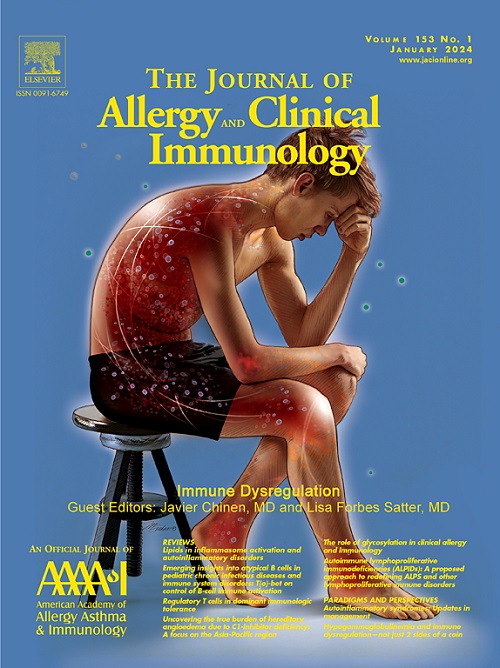Structural determinants of peanut-induced anaphylaxis
IF 11.4
1区 医学
Q1 ALLERGY
引用次数: 0
Abstract
Background
Human IgE mAbs recognizing peanut allergens have recently become available, but we lack a detailed understanding of how these IgEs target allergens.
Objective
We sought to determine the molecular details of the antibody-allergen interaction for a panel of clinically important human IgE mAbs and to develop strategies to disrupt disease causing antibody-allergen interactions.
Methods
We identified candidates from a panel of epitope binned human IgE mAbs that recognize 2 important and homologous peanut allergens, Ara h 2 and Ara h 6. Crystal structures were determined revealing the interfaces (antigenic sites) of exemplars of 5 common IgE bins.
Results
Among the common antigenic sites on Ara h 2 and Ara h 6, 2 sites (A and B) are highly conserved between the allergens, explaining the cross-reactivity of antibodies that recognize these sites. Three sites (C, D, and F) involve residues that are not conserved between the allergens. Of the 5 common sites, 3 sites (B, C, and D) involve residues that are near each other only when the allergens are properly folded, such that these sites are conformational. Two additional sites (sites A and F) involve largely linear stretches of amino acids. Site F targeted antibody, 38B7, binds to a peptide sequence DPYSPOHS, in which hydroxylation of the last proline is critical for binding. This sequence is repeated 2 or 3 times depending on the Ara h 2 isoform, enabling 38B7 to induce anaphylaxis as a single mAb, without a second antibody. We have mutated key residues in each site and created a panel of hypoallergens, having reduced IgE mAb binding and lacking the ability to induce anaphylaxis in our murine model.
Conclusion
We created a structural map of the IgE antibody response to the most important peanut allergen proteins to enable the design of new allergy immunotherapies and vaccines.
花生诱发过敏性休克的结构决定因素。
背景:识别花生过敏原的人单克隆IgE抗体最近已经可用,但我们缺乏对这些IgE如何靶向过敏原的详细了解。目的:确定一组临床重要的人IgE单克隆抗体抗体-过敏原相互作用的分子细节,并制定策略来破坏引起疾病的抗体-过敏原相互作用。方法:我们从一组表位结合的人IgE单克隆中鉴定出候选基因,这些基因可以识别两种重要的同源花生过敏原,Ara h2和Ara h6。通过晶体结构分析,揭示了5种常见IgE桶样品的界面(抗原位点)。结果:在Ara h 2和Ara h 6的常见抗原位点中,A和B两个位点在过敏原之间高度保守,这解释了识别这些位点的抗体的交叉反应性。三个位点(C, D和F)涉及在过敏原之间不保守的残基。在五个常见位点中,三个位点(B、C和D)涉及的残基只有在过敏原正确折叠时才彼此靠近,因此这些位点是构象的。另外两个位点(位点A和位点F)主要涉及氨基酸的线性延伸。位点F靶向抗体38B7与肽序列DPYSPOHS结合,其中最后一个脯氨酸的羟基化对结合至关重要。该序列根据Ara h2亚型重复两到三次,使38B7能够作为单克隆诱导过敏反应,而不需要第二抗体。我们对每个位点的关键残基进行了突变,并创建了一组低过敏原,减少了IgE单抗的结合,并且在我们的小鼠模型中缺乏诱导过敏反应的能力。结论:我们建立了花生最重要过敏原蛋白的IgE抗体反应结构图,为设计新的过敏免疫疗法和疫苗提供了基础。
本文章由计算机程序翻译,如有差异,请以英文原文为准。
求助全文
约1分钟内获得全文
求助全文
来源期刊
CiteScore
25.90
自引率
7.70%
发文量
1302
审稿时长
38 days
期刊介绍:
The Journal of Allergy and Clinical Immunology is a prestigious publication that features groundbreaking research in the fields of Allergy, Asthma, and Immunology. This influential journal publishes high-impact research papers that explore various topics, including asthma, food allergy, allergic rhinitis, atopic dermatitis, primary immune deficiencies, occupational and environmental allergy, and other allergic and immunologic diseases. The articles not only report on clinical trials and mechanistic studies but also provide insights into novel therapies, underlying mechanisms, and important discoveries that contribute to our understanding of these diseases. By sharing this valuable information, the journal aims to enhance the diagnosis and management of patients in the future.

 求助内容:
求助内容: 应助结果提醒方式:
应助结果提醒方式:


